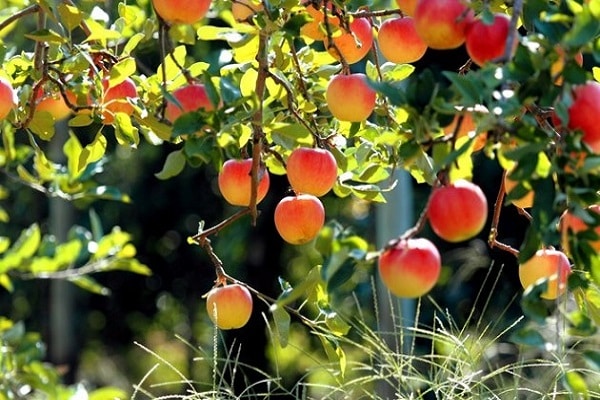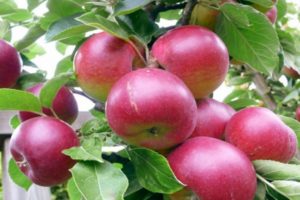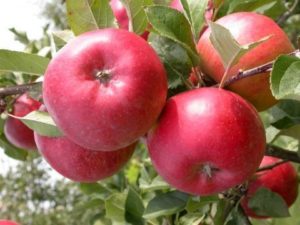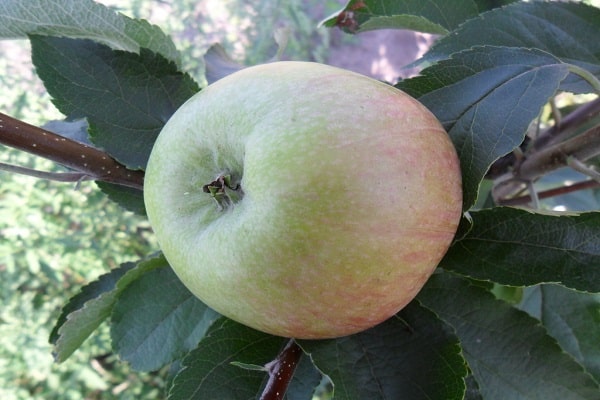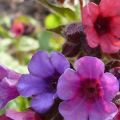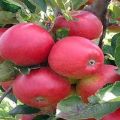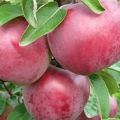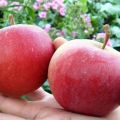Description of the variety of apple trees Medunitsa and its rootstocks, features of planting, cultivation and care
Cold climatic zone - Siberia, Ural, suitable for growing the Medunitsa apple tree, according to gardeners, it is the best summer variety in the middle zone. It is in this climatic zone that its fruits have a high acidity. Lungaria has a sweet taste, not typical for apple trees in the middle zone and northern regions. The Medovka variety, more resistant to severe frosts, in contrast to it, has a sour taste.
Description
The characteristics of the variety may differ slightly depending on the rootstock. Due to this, the variation in the descriptions of tree height, fruit weight, density and structure of the pulp may differ slightly.
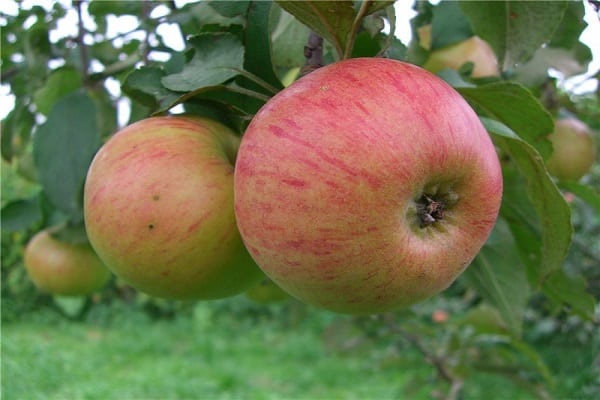
Appearance
The height of the tree is from 5 to 10 meters. Uncharacteristic crown outlines for summer varieties - a wide, inverted pyramidal shape. Skeletal branches branch off from the trunk with a downward slope at an acute angle. On two-year-old seedlings, the shoots are light brown with ringlets.
Trunk
The height of the Medunitsa tree on a dwarf rootstock is 1.5-2 m. On a semi-dwarf tree, the trunk reaches a height of 5 m, on seed and columnar apple trees they grow gigantic - up to 8-10 m in height.
Foliage
The foliage is green matte, rough to the touch with an embossed depressed pattern. It has no definite shape, there are rounded and oblong leaves of different lengths and widths. A light yellowish tint is a natural characteristic of the variety, as well as a light, weakly pronounced curvature of hard leaves.

Fetus
The summer variety Medunitsa is characterized by rounded fruits weighing up to 100 g. Apples, taken at the stage of technical maturity, are stored for no more than 2 weeks. Maturation is non-simultaneous. The harvest of winter Medunitsa retains its qualities until mid-autumn. The fruits of the winter variety reach 150 g. Like the leaves, apples do not have a strict shape; among the rounded apples you can find conical fruits, which is not a degeneration of the variety. Most often, the fruits are elliptical when viewed from the side.
Ripe apples, suitable for harvest, are yellow-green in color with scarlet stripes.The fruit, the table maturity of which occurs while it is on the branch, may differ in the red color of a dense, smooth skin or blush prevailing over other shades. However, vertical stripes remain visible.
The yellow pulp has a dense, juicy structure. Tasting score 4,3 points out of 5 possible. The taste of apples of the Medunitsa variety lives up to its name - there are honey notes in the aroma and taste.
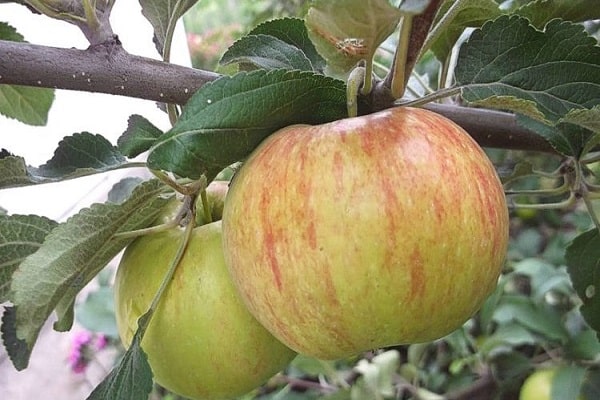
Root
In summer varieties of Medunitsa on seed, columnar rootstocks, the root system is developed enough to securely hold the tree even in hurricane winds. When using dwarf and semi-dwarf rootstocks, the roots of the tree are located close to the surface, which requires additional fixation of the plant using props.
During severe bad weather, the root system will not provide the tree with reliable support; storm winds can uproot the tree from the ground.
Types and variations of rootstocks and varieties
The choice of a tree according to the characteristics of the rootstock is necessary for areas with strong winds, certain types of soil. The stock depends on:
- height of an adult plant;
- the period of its fruiting and life expectancy;
- the timing of the ripening of the crop.
Depending on the characteristics of the stock, the stages of care will differ - fertilization, root and foliar dressing, pruning.
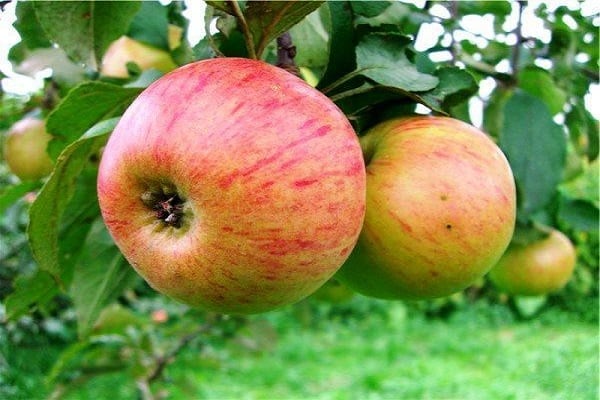
Summer dessert
A tall apple tree over 5 years old yields a yield of 80 kg annually. The weight of each fruit is from 80 to 150 g. The juicy fragrant pulp is creamy.
Winter
Winter Medunitsa differs from the summer varieties of the variety in terms of fruit ripening, it falls on the end of September. The harvest from this tree can be preserved until spring, it is distinguished by its high keeping quality. The peculiarity lies in the higher content of acids in the fruits; apples taste more like Medovka.
Dwarf
The height of the tree is insignificant - 1.5-2 m. When planting, the minimum interval between plants is 1 m. Low-growing Lungwort begins to bear fruit in the 3rd year after planting a one-year seedling. When planting a 2-year-old shoot, you can try the first fruits already in the first season, but the tree is not yet gaining sufficient strength, which can affect the wintering period in severe frosts. Therefore, it is recommended to remove the ovaries in the first year.

To provide the plant with good rooting, high-quality development, a garter is needed. A healthy, evenly developed crown will yield maximum returns for 12 seasons after first fruiting. The main disadvantage dwarf apple trees in their short life span.
Semi-dwarf
A semi-dwarf rootstock will make Medunitsa not so tall and will bring the gardener's joy from getting the first harvest closer. The height of a tree on a semi-dwarf rootstock is 4-5 m, such a Medunitsa will begin to bear fruit in the 4-5th season. The minimum spacing between seedlings should not be less than 3 meters.
Columnar
Columnar rootstock is used when it is necessary to obtain a pyramidal dwarf plant. It is almost impossible to get such a plant from a nursery; such an inoculation is more often used by the gardeners themselves.

Seminal
An apple tree on a seed stock lives up to 90 years, it will bear fruit for more than half a century. The height of the tree reaches 5-7 meters, it will begin to bear fruit in the 5-6th season after planting in a permanent place. The distance between the planting holes of Medunitsa apple trees on the seed stock is at least 4.4 m. In order for the crowns not to shade each other, the optimal distance between the holes is 6 meters.
Advantages and disadvantages of varieties
A characteristic feature of the Medunitsa variety (of all species) is that the fruits practically do not fall off after full ripening, they are firmly held on the branches. With prolonged storage, the fruits lose their taste. Ripening of fruits on one tree is uneven, 2-3 weeks can pass from the first ripe apple to the last.
An apple tree on a dwarf rootstock practically does not require thinning of branches, while for normal fruiting of a tree on a seed rootstock, regular pruning of the crown is required. Seed stocks provide fruiting for at least half a century, and dwarf trees live no more than 30 years, their fruiting period does not exceed 15 seasons.
Whichever rootstock is used, all flaws can be corrected with the right care.
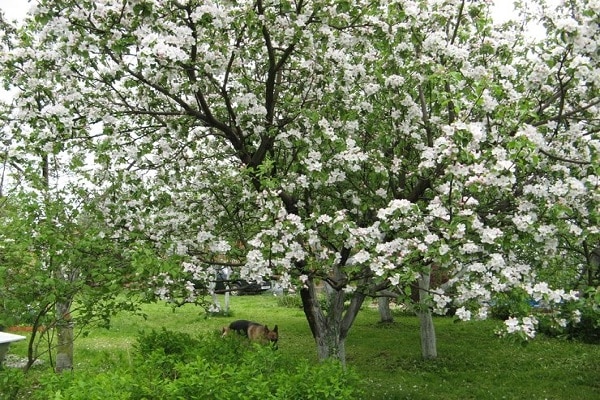
Attention! For wet areas, it is better to choose a plant on a clonal rootstock, it increases the apple tree's resistance to excessive soil moisture.
Comparisons with other varieties
Compared with the varieties Medovka, Medok and Candy, then:
- Medunitsa has the highest resistance to disease.
- In terms of fruit weight it is inferior to Medka and Medovka.
- The taste of the fruit is characterized as sweet with a honey flavor. The same description has Medoc apples... The fruit of the Candy variety is simply called sweet, and Medovka has a sweet and sour taste.
- In comparison with the same varieties, Medunitsa has the highest yield with good transportability.
- In terms of the shelf life of the crop - one and a half months, it is second only to Candy, the fruits of which can retain marketable qualities for 2 months.
- Frost resistance is higher only in Medovka.
- You can eat fresh, cook preserves, jams, compotes for long-term storage from all 4 varieties listed above. Suitable for drying only Candy apples.
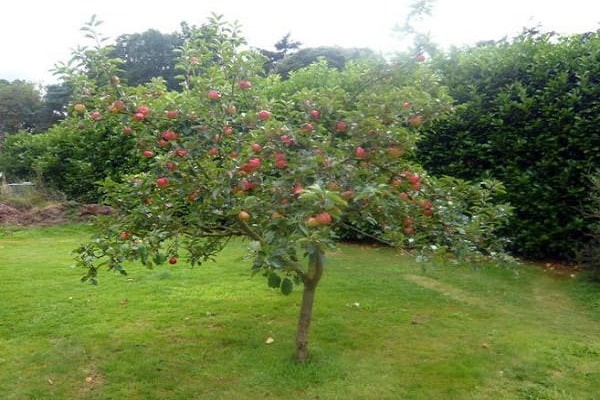
Benefits of varieties
Honey Ranet and Summer Honey can be considered worthy competitors of Medunitsa, but they are inferior to her in some parameters. Honey Ranet loses in terms of such indicators as:
- fruit size;
- richness of taste;
- less resistance to disease;
- yield.
Summer Honey Medunitsa is inferior in transportability, but it wins significantly in terms of disease resistance.
Specifications
Candy - a variety that ripens for the Apple Savior, bred by S.I. Isaev. Bears fruit in the 5-6th season. Frost-resistant, grows in central Russia. Productivity up to 100 kg from an adult (10-year-old) plant. The variety is self-fertile, used as a pollinator for other varieties of apple trees.
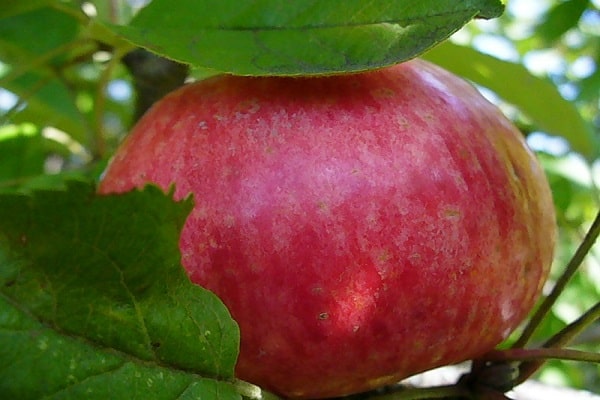
Medovka is an early ripening variety. The tree is frost-resistant, in case of damage by strong cold it quickly regenerates. Unstable yield - a break for one season every 4-5 years, compensated for by the high taste of the fruit. The height of the tree is 4-4.5 m.
Medoc is a columnar tree, about 2 meters high. Ripens in late August - early September. During the season from one tree you can get 15 kg of apples. Begins to bear fruit in the 2nd year.
Honey Ranet is a variety of early ripening, tree height 4-4.5 m, small apples 35-70 g, yellow color. Productivity, frost resistance are high.
Summer Med is offered by the Kurilovsky nursery. This variety is new for Russia, it was developed in Europe. Fruits with a pale pink skin ripen by mid-August, their average weight is 230 g. The pulp is juicy, fine-grained, dense. The taste is sweet and sour.
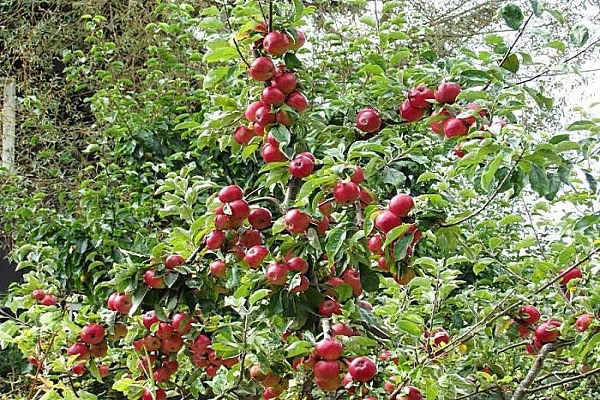
Crown formation
Formation of the crown of apple trees depends on the height of the tree. The optimal growth of the trunk in height is 60 cm, if this level is exceeded, then the crown needs pruning. With lower growth rates of apple trees that do not belong to dwarf species, it is necessary to make additional fertilizing with growth regulators.
Pruning branches is not a mandatory step in the annual care of apple trees on dwarf and columnar rootstocks. For tall trees, it is necessary to carry out the formation of the crown by shortening the shoots.
Flowering and pollination
Lungwort is a self-fertile apple tree, but the quality of the harvest largely depends on what sort of apples are planted in the neighborhood, whether they can become pollinators for Lungitsa. The best neighbors can be considered for Medunitsa:

- Brown Striped;
- White filling;
- Victory;
- Belfer to a Chinese woman;
- Chernenko;
- Anis Sverdlovsky.
When choosing a neighborhood that has a beneficial effect on the yield of Lungwort, it is necessary to take into account the fact that pollinating varieties should bloom with it at the same time in May.
Fruiting
Fruiting of Lungwort on all types of rootstocks is consistently high (for a given tree size). If we are talking about a dwarf rootstock, then from one 2-meter tree you can get 15 kg of fruit, and from a high 7-meter tree all 80 kg.
The lower the tree should be at a later stage of development, the faster the first crop can be removed from it. Tall plants take longer to enter the stage of maturation, but their fruiting period is 40-50 seasons longer.
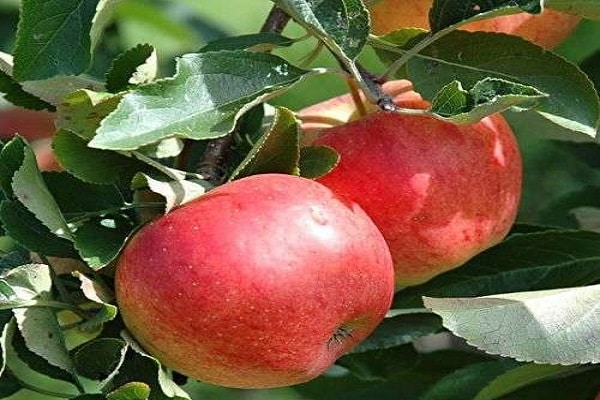
Winter hardiness
The lungwort is resistant to frost down to -40 ° C and frosts returning in the spring. It is successfully cultivated in the conditions of the Urals and Siberia. The taste of the fruit is not affected by the growing conditions.
Disease resistance
Initially, the breeders were faced with the task of creating a variety that is resistant to scab. The goal was achieved, Medunitsa turned out to be resistant to other diseases of apple crops.
Disease strains are being transformed, today Medunitsa is again susceptible to damage from a new generation of scab, because she has immunity only from scab species known in the 40s of the last century. Preventive treatments for scab against Medunitsa are necessary in the same way as other varieties of apple trees.
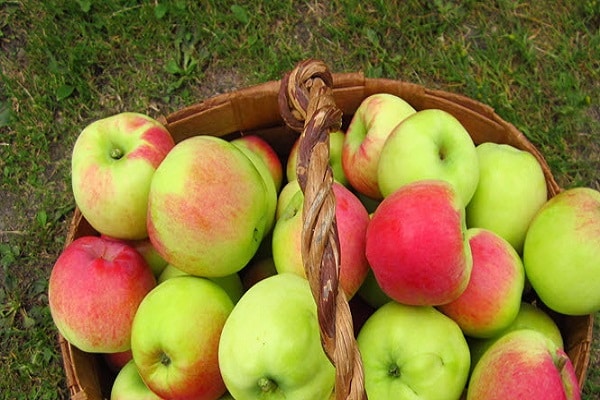
Selection
The Medunitsa apple tree was bred as a result of crossing the Brown Striped and Welsey. The authorship belongs to S.I. Isaev, who has been working on improving the variety since 1935 on the basis of Moscow State University. Lomonosov. In 1944, the apple tree was harvested for the first time with its characteristic honey notes.
The biologist was awarded the Stalin Prize for his work, but the Medunitsa variety does not appear in the State Register of Fruit Trees.
Agricultural technology of cultivation
The cultivation technique of the Medunitsa variety largely depends on the climate of the region. This affects the timing of treatments, fertilizing, pruning, planting seedlings, because the criteria are not calendar dates, but natural factors - snow melting, thawing of the ground, the onset of stable positive air temperatures.
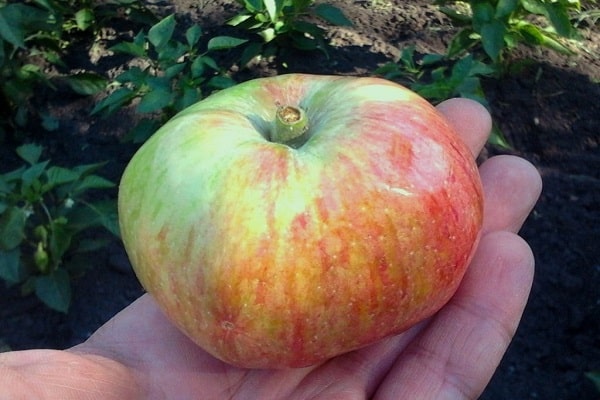
Landing
It is recommended to plant an apple tree in the Caucasus, central Russia and other regions where snow covers the ground with a dense carpet in winter, 15-20 days before the onset of frost. In this case, there should be no possibility of warming, at which the movement of the tree sap and the swelling of the buds begin.
If even one factor can be questioned, then tree planting should be planned for the spring. In the spring, the apple tree must be planted in the Urals, Siberia, and regions of the Far East. And the holes for planting need to be prepared in the fall, adding the necessary minerals and humus to them.
The depth of the hole and its distance from the neighboring one must be selected as the plant requires on the selected type of rootstock.
The choice of planting material
Each region has its own preferred rootstock varieties. Professional breeders working in garden plant nurseries will help in choosing planting material. It is difficult to briefly describe all the nuances of the choice, choosing a plant for each specific site, taking into account the density and fertility of the soil, temperature differences during the day and year, the proximity of groundwater, the windiness of the area and other factors.
Choosing a landing site
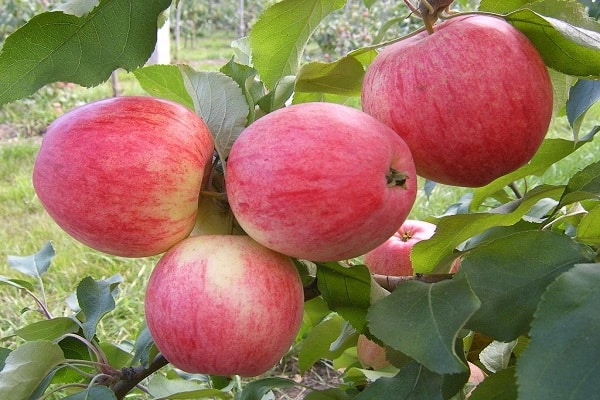
Loam is the best soil for Medunitsa with sufficient drainage and an abundant content of mineral elements. On other soils, it is also necessary to provide the plant with sufficient light, access of air and nutrients to the roots, and a good outflow of excess water.
Timing
When planting seedlings in autumn, the last decade of October is recommended. In the spring, the landing time directly depends on the moment the snow melts. The ground should not be overly moist.Although the variety Medunitsa is resistant to moisture, long-term contact with water is undesirable for the roots of the seedling.
Sequence of actions for landing
Landing Algorithm:
- The hole is dug in width and depth twice as large as the diameter of the seedling root system itself.
- At its bottom, a part of the soil enriched with mineral fertilizers and humus is laid out. The thickness of this layer is approximately 20 cm.
- A peg is driven into the center so that its upper part protrudes above the surface.
- The roots of the tree are immersed in the hole, the trunk is fixed in an upright position, tied to a peg.
- The root system is covered with the remaining earth so that the root collar rises 5 cm above the ground.
- The earth around the trunk is compacted.
- A ditch is made at a distance of 50-70 cm from the trunk for irrigation. Its circumference should not coincide with the ends of the root system.
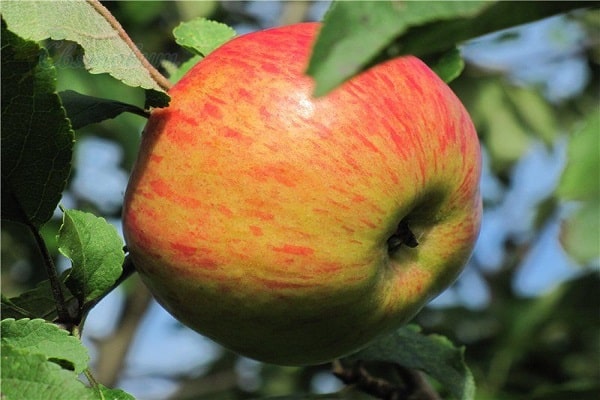
Growing
The cultivation of Medunitsa consists in proper care - feeding, protective measures against diseases and insect pests, periodic watering, crown formation and thinning, loosening the soil to ensure that the soil is saturated with air.
Care
The lungwort is not one of the demanding varieties, but you still need to take care of it regularly, starting in early spring and ending in late autumn with preparation for the winter cold.
Pruning
Pruning of branches is carried out in the spring before the onset of warm weather - until the moment when the sap of the tree begins to move and the buds swell. In the spring, old and frost-damaged branches are removed, and there is no hope for their restoration. In the fall, shoots are removed, taking power from the main trunk.
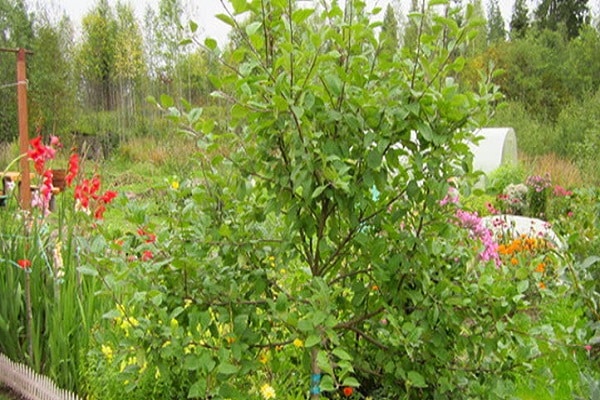
When forming a crown, Medunitsa should have 5-6 main skeletal branches. Of all the shoots, the strongest branches are selected at the pruning stage. When pruning, you need to have a garden varnish or water-based paint on hand for processing fresh cuts.
Leaving during flowering
During flowering, the apple tree requires nitrogen, it is applied with top dressing in May and early June. For young plants, urea is added at the same time, it is a growth activator. Urea is added in a ratio of 1 to 5 with water. Infusion of chicken manure and nettle can be used as a nitrogen-containing liquid.
You can replace these folk remedies with Kemira Lux, which is used as a top dressing at the stage of bud formation.
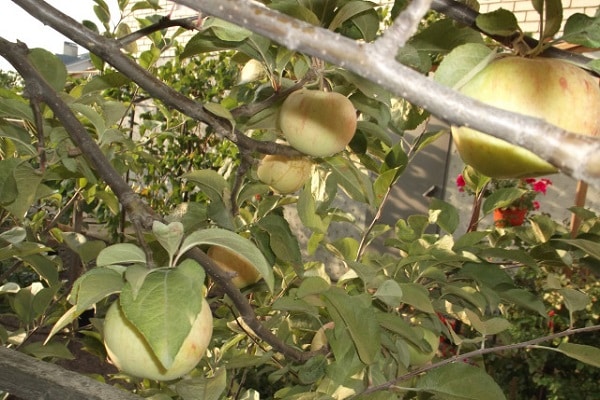
Watering
For watering an adult tall apple tree, 30-40 liters of water will be required, for a young or dwarf Medunitsa 10 liters are enough. Watering frequency depends on weather conditions. Under moderately warm conditions, irrigation is carried out once every 15 days, in a hot arid climate, irrigation can be done much more often, 2 times a week.
Pest control
In early spring, for preventive purposes, it is useful to spray an apple tree of the Medunitsa variety against pests with a herb elderberry broth. 1 kg of leaves and flowers is poured into 10 liters of water, insisted for a day, 50 g of laundry soap is added. In spring and autumn, the trunks of apple trees are whitened, this scares off crawling insects.
Disease protection
Prevention of scab and fruit rot consists in watering a plot of land adjacent to the trunk with a 10% solution of ammonium nitrate. The tree itself is treated with a 2% solution of Bordeaux liquid. Copper sulfate is used before the kidneys swell. The proportion of dilution is 100 g per 10 liters of water.
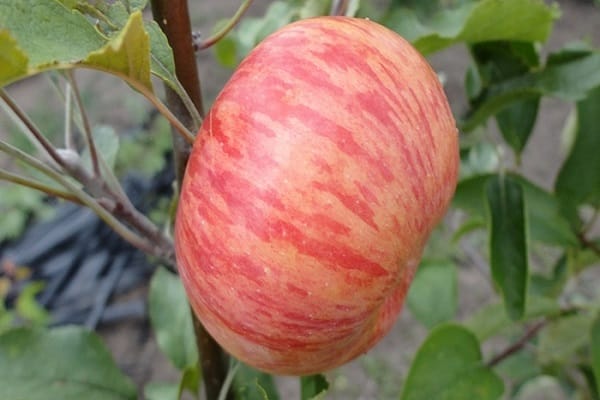
Top dressing
In addition to saturating the soil with nitrogen 3 times during the season, the apple tree needs minerals. The most important thing is the saturation of the soil with organic fertilizers - humus, slurry during the spring digging.
In areas with severe winters, dry cow cakes with straw can be used to warm the soil around the root system. In the spring, manure with melt water will enter the soil, enriching it with essential nutrients.
Necessary feeding
Bacterial fertilizers improve the soil, increase yields. These include:
| Mineral | Organic |
| "Nitragin" | Manure |
| Azotobacterin | Humus |
| "Phosphorobacterin" | Compost |
| "Guano" |
Foliar dressing
For foliar feeding, carbamide, superphosphates, calcium phosphate, potassium salt are used. Boron, manganese, molybdenum and other minerals should be supplied in small quantities, they are also part of the foliar feeding.
Harvest
In view of the peculiarity of the fruits of Lungwort, to change the taste, it should be determined whether it is so important to keep the crop fresh, or whether it is better to put apples for processing. The most pronounced aroma and rich honey flavor usually lasts no longer than two weeks after harvest.
Collection
The harvest from the Medunitsa apple tree can be harvested in a state of technical ripeness and fully ripe. Given the non-simultaneous ripening of the fruits of Medunitsa, the summer variety is harvested from the last decade of August to the last days of September. The winter variety ripens 2-4 weeks later, but it is also heterogeneous in ripeness, which suggests harvesting from mid-September to late October.
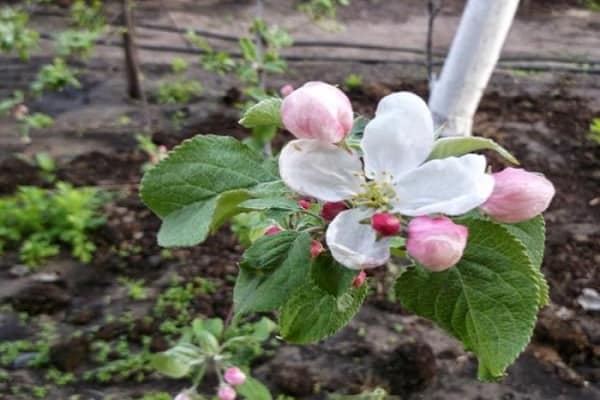
Safety
Winter Medunitsa is stored for 3-4 months, summer varieties are not more than a month.
Fruit use
Medunitsa apples are recognized as dessert, but despite this, they are great for making compotes, jams, and preserves. Low acidity protects winter preparations from fermentation. This variety is poorly suited for drying.
To help the gardener
It is not so easy for amateur gardeners to get a seedling of the Medunitsa apple tree, even at an agricultural fair. And not all sellers on such impromptu trading platforms deserve trust. It is better to buy varietal apple trees in organizations that are professionally engaged in breeding; their representatives rarely take out seedlings hundreds of kilometers from the nursery.
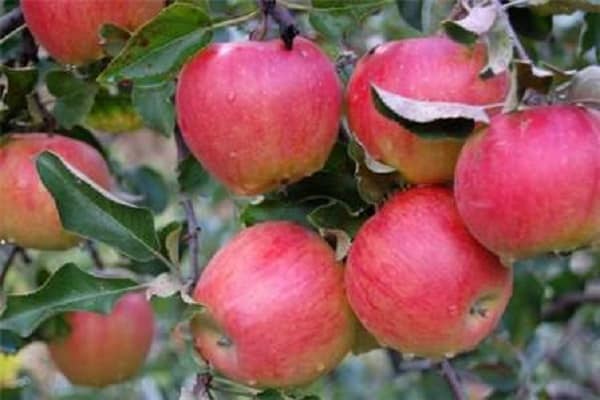
Saplings price
The cost of apple seedlings of the Medunitsa variety in nurseries varies from 350 to 500 rubles. This is the cost of next year, because many are already taking orders for the spring delivery of seedlings.
Production regions
The regions of production of Medunitsa seedlings are St. Petersburg, Moscow, the Urals, the Caucasus. Wherever the Medunitsa apple tree grows, private and state nurseries offer seedlings on rootstocks that are most suitable for the climate in the region.
Nurseries
There are apple tree nurseries in almost all regions. There are a lot of them in the central zone of Russia. Only in the Leningrad Region apple trees can be bought at 33 points.
There are 91 fruit tree nurseries on the territory of Moscow and the region, in 55 of them you can buy apple trees. The Urals and Siberia also have their own nurseries. When choosing an organization that sells seedlings, it is better to give preference to nurseries related to scientific agricultural institutions.
